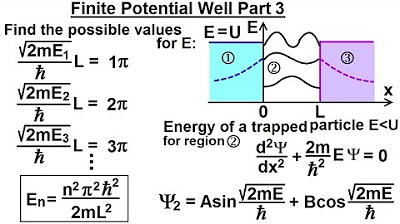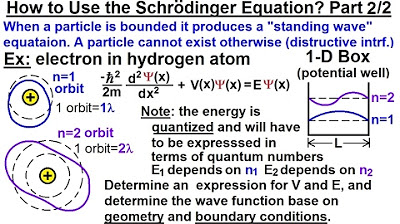Physics - Ch 66 Ch 4 Quantum Mechanics: Schrodinger Eqn (33 of 92) Finite Potential Well Part 2
TLDRIn this lecture, the focus is on the middle region of a finite potential well, where particles can exist with energy greater than zero. The Schrödinger equation for this region is explored, revealing that the wave function consists of sine and cosine terms. It's explained that for the wave functions to be continuous across regions, certain conditions must be met, leading to quantized energy levels, denoted as a_sub_N. The discussion also touches on the physical implications of these quantized energies and the expected behavior of particles within the potential well, setting the stage for further exploration of these quantized states.
Takeaways
- 📍 The middle region (region 2) of a finite potential well allows particles to exist freely with energy greater than zero.
- 🚧 In a finite potential well, a particle can partially exist in the barrier regions, unlike an infinite barrier where presence is not possible.
- 📝 The Schrödinger equation for the middle region is given by a general solution involving sine and cosine functions with constants A and B.
- 🌐 The energy (E) in region 2 is determined by the equation √(2mE/ħ²), where m is the mass of the particle and ħ is Planck's constant divided by 2π.
- ✂️ For an infinite barrier, B must be zero, but in region 2, B can have a value since the barrier is not infinitely high.
- 🔄 The wave function in region 2 must match the wave functions in regions 1 and 3 at the boundaries to ensure continuity.
- 🌟 The constant B from region 2 must equal the constant C from region 1 to maintain the continuity of the wave function.
- 🔢 The energy levels in the well are quantized, denoted as E_sub_N, meaning they can only take on specific, discrete values.
- 📊 The physical structure of a finite potential well requires that the wave functions in region 2 align with those in regions 1 and 3 for a valid solution.
- 🌈 The wave functions in region 2 can exhibit different shapes that match up with regions 1 and 3, showing a decaying presence in the barriers and specific behavior within the well.
Q & A
What is the condition for a particle to reside freely in region number two of a potential well?
-The energy required for a particle to reside in region number two must be anything larger than zero.
How can a particle exist in the barriers on either side of a finite potential well?
-A particle in a finite potential well can exist in the barriers on either side for a part of the time or within a small region, due to quantum mechanical effects.
What equation is used to describe the energy of a particle within region two of a potential well?
-The Schrödinger equation is used to describe the energy of a particle within region two.
What does the term 'h-bar' represent in the context of the Schrödinger equation?
-H-bar represents Planck's constant divided by two pi in the context of the Schrödinger equation.
Why must the constant 'B' be zero when dealing with an infinite barrier in a potential well?
-B must be zero for an infinite barrier because for x equals zero, the cosine of zero equals one, and for an infinite barrier, the wave function must be zero at the barrier, necessitating that B, which multiplies the cosine term, be zero.
How is the continuity of the wave function between regions ensured in a finite potential well?
-The continuity of the wave function between regions is ensured by matching the function solutions at the boundaries of each region. For example, the solution for region two at x equals zero must equal the solution for region one at the same point.
What leads to the quantization of energy levels within a finite potential well?
-The quantization of energy levels within a finite potential well is a result of the requirement that the wave function solutions match at the boundaries of each region. This condition can only be satisfied for specific energy values.
Why is it important for the wave function solutions to match at the boundaries of the regions in a potential well?
-It's important for the wave function solutions to match at the boundaries to ensure physical continuity and the conservation of probability, reflecting the continuous and unbroken nature of the particle's presence across the well.
What role does the wave function play in determining the behavior of a particle in a potential well?
-The wave function describes the quantum state of a particle, including its position and energy. It determines the probable locations of a particle in a potential well and the allowed energy levels, influencing the particle's behavior.
How do the quantized energy levels affect the particle's behavior in region two of a potential well?
-The quantized energy levels restrict the particle to specific energy states, leading to discrete possible behaviors and locations within region two. This quantization reflects the quantum mechanical nature of particles and their constrained motion in a potential well.
Outlines
📚 Quantum Mechanics: The Middle Region and Energy States
This paragraph delves into the quantum mechanics of a particle within a finite potential well, focusing on the middle region (region two) where particles can exist freely with energy levels above zero. It discusses the Schrödinger equation for this region, highlighting the general solution involving sine and cosine functions with constants A and B. The importance of matching the solutions at the boundaries of the potential well is emphasized, leading to the concept of quantized energy levels, denoted as E_sub_N. The discussion sets the stage for exploring the behavior of particles in confined spaces and the emergence of discrete energy states.
🌐 Finite Potential Well: Matching Solutions Across Regions
The second paragraph continues the exploration of quantum mechanics, specifically focusing on how the solutions for the wave function in the middle region (region two) must match with those in regions one and three for a finite potential well. It explains the physical necessity for the wave functions to align at the boundaries, which results in a series of equations that allow for quantized energies. The paragraph underscores the importance of these quantized energy levels in understanding the particle's behavior within the well and the implications for the shape of the potential well.
Mindmap
Keywords
💡particle
💡finite potential well
💡Schroedinger equation
💡energy
💡mass
💡Planck's constant
💡quantized energies
💡wave function
💡barrier
💡cosine and sine functions
💡continuity
Highlights
The middle region (region number two) is where a particle can reside quite freely, requiring any energy larger than zero.
A particle in a finite potential well can partially exist in the barriers on either side, which will be explored more later.
The Schrödinger equation for the middle region is given, with energy (E), mass (M), and Planck's constant (h-bar) as key components.
The general solution to the differential equation involves sine and cosine functions with constants A and B.
The determinant from the equation will be the square root of 2mE/H bar, affecting both the sine and cosine parts of the solution.
For an infinite barrier, B must be zero; this is not the case for a finite barrier where B can have a value.
The function solution for region two must equal the function solution for region one at X equals zero, leading to the conclusion that B equals the constant from region one.
The solution for region two must also equal the solution for region three at X equals L, indicating a continuation of the function across the well.
Quantized energies (denoted as ε_sub_N) allow for specific values that match the solutions on the left and right sides of the well.
The constant B must equal the constant C from region one for the solutions to match on the left side of the well.
The wave functions must match up for specific values of the angle for sine and cosine, leading to quantized energy levels.
The presence of a decaying function in region one inside the barrier and a matching function in region three is necessary for a coherent solution.
The physical structure of a finite potential well requires that the solutions in region two align with those in regions one and three.
Transcripts
Browse More Related Video

Physics - Ch 66 Ch 4 Quantum Mechanics: Schrodinger Eqn (34 of 92) Finite Potential Well Part 3

Physics - Ch 66 Ch 4 Quantum Mechanics: Schrodinger Eqn (17 of 92) How to Use Schrod. Eqn: 2

23. Quantum Mechanics V: Particle in a Box

Physics - Ch 66 Ch 4 Quantum Mechanics: Schrodinger Eqn (55 of 92) Solution of the Oscillator

Lecture 11: Dispersion of the Gaussian and the Finite Well

22. Quantum mechanics IV: Measurement theory, states of definite energy
5.0 / 5 (0 votes)
Thanks for rating: